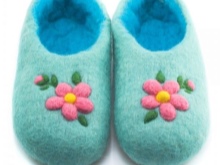Felt is a dense non-woven fabric. It happens both natural from 100% sheep wool, and from synthetic fibers.
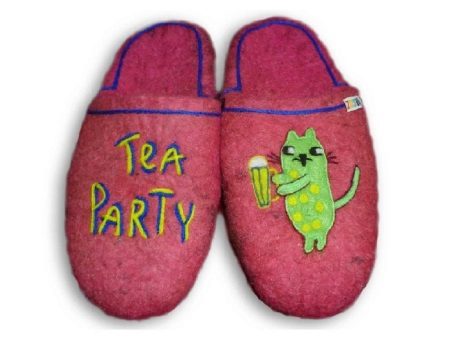
Felt can be made in the factory, or it can be felted manually by wet felting.

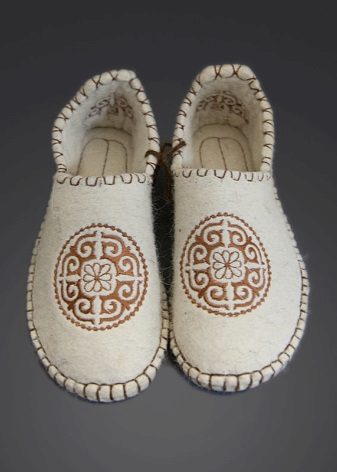
The most famous felt product in Russia are felt boots. According to Dahl's explanatory dictionary, all felt shoes are called felt boots. A few centuries ago, boots in villages were worn not only on the street, but also in the house, and even in summer. Now felted slippers revive this tradition. What is the uniqueness of natural felt and shoes made of it?

Benefits
Modern researchers have come to the conclusion that shoes made of natural wool have a therapeutic and prophylactic effect on the human body. Felt shoes help to improve blood circulation in the legs due to the fact that prickly hair fibers massage the feet while walking. After a few days of use, sweating of the legs is significantly reduced, and the feet always remain warm, because natural sheep's wool can absorb up to 40% of water.

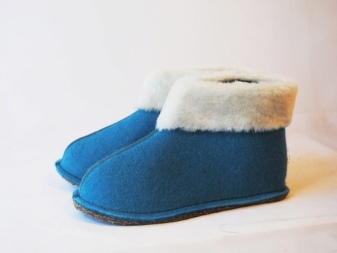



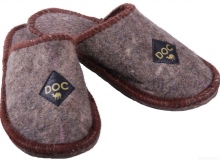


Natural fat, lanolin contained in the wool, has an antiseptic effect. Thanks to him, felt slippers can protect the feet from fungal diseases. Lanolin also helps to soften and respect the skin, has a beneficial effect on the joints. Felt slippers help relieve foot fatigue, muscle pain and relieve stress. The effectiveness of felt shoes in the fight against arthritis, heaviness in the legs and the onset of colds has been proven.

Models
The advantages of felt slippers over other models of slippers are obvious, so it is not surprising that they are chosen by adults and children, men and women. Felted slippers are a great many. Handmade all-slippers are very popular.Such shoes are seamless.

- all-slippers-ballet slippers. Sometimes masters perform this model with a strap on a button, giving slippers even more femininity and tenderness.



- Classic slippers. They come with an open or closed toe, with a back and without it. Slippers slippers are most often chosen by men. They are comfortable, practical, easy to remove and put on.


- slippers or simply shortened boots. Such a model will suit lovers of warmth, comfort and coziness, for example, it will be a wonderful gift for your beloved grandmothers. And also perfect for children, because they sit tight on their feet, do not interfere with outdoor games.



According to the manufacturing method, you can also separately distinguish knitted and then felted slippers. Most often, in this way, shoes are made by the craftswoman, who have no experience in felting. First, a pair of woolen socks or tracks is knitted, and then it is rejoiced by washing them in a washing machine at high temperature. These slippers are very lightweight, soft and thinner than the samovalka, but at the same time quite durable and warm.



Felt slippers of factory production are also found on sale. The most common slipper slippers model. They come both from natural wool felt and from synthetic or mixed materials.
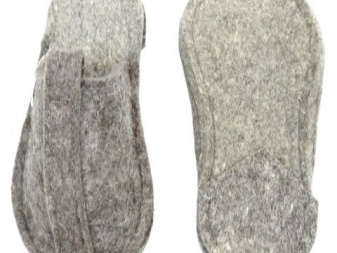

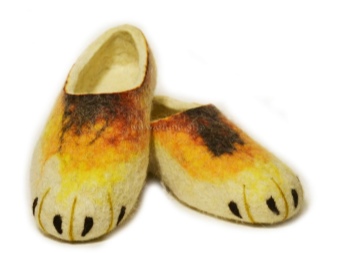

Felt slippers can also be conditionally divided by the presence of the sole. Slippers without a sole are softer and more plastic. But they are less durable and can be wiped from frequent friction on the floor. The sole of felt slippers is most often sewn to an already finished product. They make it from leather and suede, or from synthetic materials. Slippers on the sole do not slip on the floor and will last longer, retaining their original appearance. Another modern way to protect slippers from felt from rubbing is to impregnate the sole with latex. This material can be applied over the entire area of the sole, or pointwise only to make slippers more comfortable and less slippery, but at the same time leave your feet the opportunity to breathe



Felt slippers are often richly and interestingly decorated. The works of the masters are distinguished by a wide variety of decorating elements and styles. Here you can also highlight several of the most popular areas:
- decor with volumetric felted elements, for example, masters often use motifs of the animal and plant world - flowers, leaves, berries, birds and butterflies.
- drawing stuffed using the technique of dry felting. This pattern is durable, as in the process of felting it becomes an integral part of the slipper.
- the drawing applied by paints on fabric. This technique differs from the previous one in sharper contours, but it is a crust on a woolen surface, as a result of which the pattern may turn out to be short-lived. The designers’ favorite plot is traditional Khokhloma painting.
- slippers in eco-style. Here, designers focus on the beauty of unpainted felt, inserts made of genuine leather and knitted woolen elements.
- two-layer slippers from felt of contrasting colors. In this case, the top layer has curly slots, thus forming an interesting pattern. Here, for example, felt slippers stylized as well-known Crocs shoes.
- stylish slippers with elongated bent up noses. This model is suitable for fans of fairy tales about gnomes.




Material and color
Modern dyes are able to give felt almost any color and shade. If we talk about natural unpainted felt, then its color directly depends on the color of the wool from which it is made.
The main raw material for the production of felt is coarse and semi-rough wool, the fiber length of which is from 40 to 90 mm. Such wool is characterized by a wide variety of colors in a natural range: from pure white and cream, to gray and dark brown. More often, felts are made from a mixture of different wool, which gives them a melange shade.

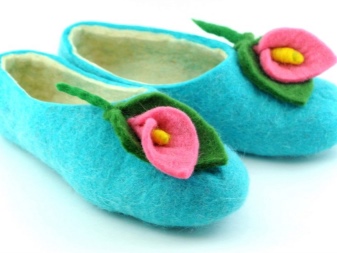


Feltmakers can use natural dyes, such as onion husks, nettle leaves, birch, pomegranate peels, henna and basma, to dye wool before felting. Shades are obtained by soft natural tones of beige-brown and gray-green colors.
To create bright shades, felts use ready-made dyes designed specifically for wool.


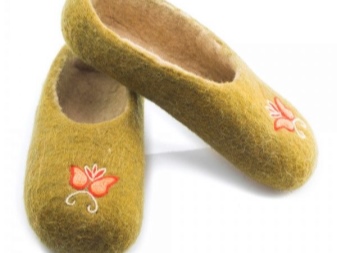

How to choose?
If you are inclined to slippers of factory production, then the most important thing is to check with the seller that they are made of natural felt without synthetic additives. Many trademarks sin in the production of acrylic or polypropylene slippers, although they do not hide this from buyers. Their products are chosen for a low price. Natural felt slippers cannot compete in this matter - their price is one time higher than synthetic analogues.




And if your choice fell on self-slippers, then the most common marriage here are under-processed products. Such slippers will quickly lose their shape, will look untidy, and spools and holes will quickly appear on them.

How to distinguish low-quality felt in a handmade product?
Here are a few signs:
- Slippers look loose, wrinkles that do not carry a decorative function are present on their surface. High-quality felt has a smooth or fine-grained structure resembling externally millet porridge. If the upper part of the slippers is decorated, feel free to view the felt from the wrong side.
- The surface of slippers looks fluffy. This is definitely a sign of marriage.
- If the cut of felt resembles puff pastry, then such a product will definitely be short-lived. It is impossible to discern the direction of the woolen fibers of high-quality felt slippers, they are so tightly piled together.
- In the case when you buy the product personally from the master, and not through the Internet, you must check the elasticity of the felt. Well-slipped slippers spring and perfectly retain their original shape.

